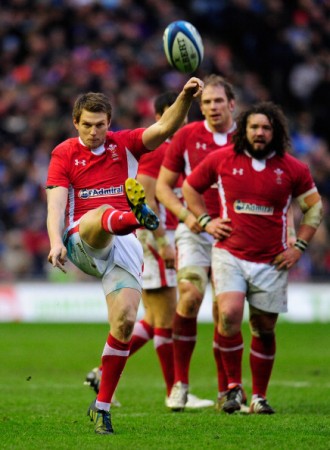By Paul Williams
Tackles count
WALES HAD a tackle completion rate of 98% against Scotland. That’s right – 98%. They only missed two tackles in 80 minutes and completed 83. It was an obdurate display, typified by Adam Jones who made ten tackles at tighthead. Shaun Edwards has recently been criticised for his over reliance on ‘the blitz’, with many calling for a switch to a less risky defensive system, but when your players are completing 98% of their tackles, it doesn’t matter which system you’re playing. As long as the opposition end up on the deck, the manner in which they get there becomes rather academic.
Super seven
Sam Warburton had a point to prove in Edinburgh – and prove it he did. It was a lesson in what it takes to be a genuine openside and not a blindside flanker who has been given the wrong shirt. Warburton’s impact at the breakdown was cold and calculating. His extra speed meant that he consistently arrived at the breakdown first and reduced Kelly Brown to a bystander. Brown spent most of the game trying to untangle Warburton from Scottish rucks – a tiring and time-consuming task. But whilst Warburton’s general display was worthy of note, his tackle and jackal on Stuart Hogg in the 42nd minute was the undoubted highlight. It was predatory, like watching one of those horribly one-sided battles from a David Attenborough documentary where a lion stalks, and then disembowels, a pitiful gazelle. Talking of Lions…
Carry on…
Wales had clearly done their homework on the Scottish ruck defence and exploited it to their advantage – particularly early on in the game. Instead of opting to carry the ball five yards to the right or left of the ruck, where ‘guard one’ and ‘guard two’ would usually lie in wait, Wales regularly chose to run directly through the back of the ruck. It was a very effective strategy and allowed some of Wales’ key ball-carriers to build some impressive multi-phase sets. Alun Wyn Jones and Richard Hibbard in particular made the ‘hard yards’, at times, look easy.
Biggar and better
Dan Biggar had another controlled game at outside-half. He is becoming a major asset in the Welsh squad. His line kicking was measured against Scotland, as was his tactical kicking – his high balls were particularly accurate and afforded the Welsh kick chasers ample opportunity to get under the ball without sacrificing distance on the kick. Biggar also had a 100% tackle completion rate and provided solid ‘sweeping’ cover when Leigh Halfpenny found himself further up the pitch. Yet supporters still seem a little reluctant to heap praise on Biggar – his name is rarely mentioned by fans when sipping they’re their post-match pints. But perhaps we shouldn’t judge Biggar’s form on how often is name is brought up in conversation. Instead we should maybe focus on how often James Hook’s name crops up – currently that’s few and far between.
Paying the penalty?
Scotland accumulated 16 penalties and two free-kicks against Wales in what was an ill-disciplined affair all round. Wales weren’t exactly blameless as they conceded 12 penalties. Yet despite racking up a sizeable penalty count the referee deemed it unnecessary to show Scotland a yellow card. It may seem churlish to mention this point after the whistle has blown and the result is decided. However, the decision not to reduce Scotland to 14 men has implications beyond the game in Edinburgh – it also affects next week’s game in Cardiff against England. Yellow cards dictate winning margins and points differences on the championship table. On average a team concedes approximately six points whilst they have a player in the bin – six points that could have an enormous impact on the championship decider in Cardiff.
Follow Paul Williams on Twitter @thepaulwilliams









